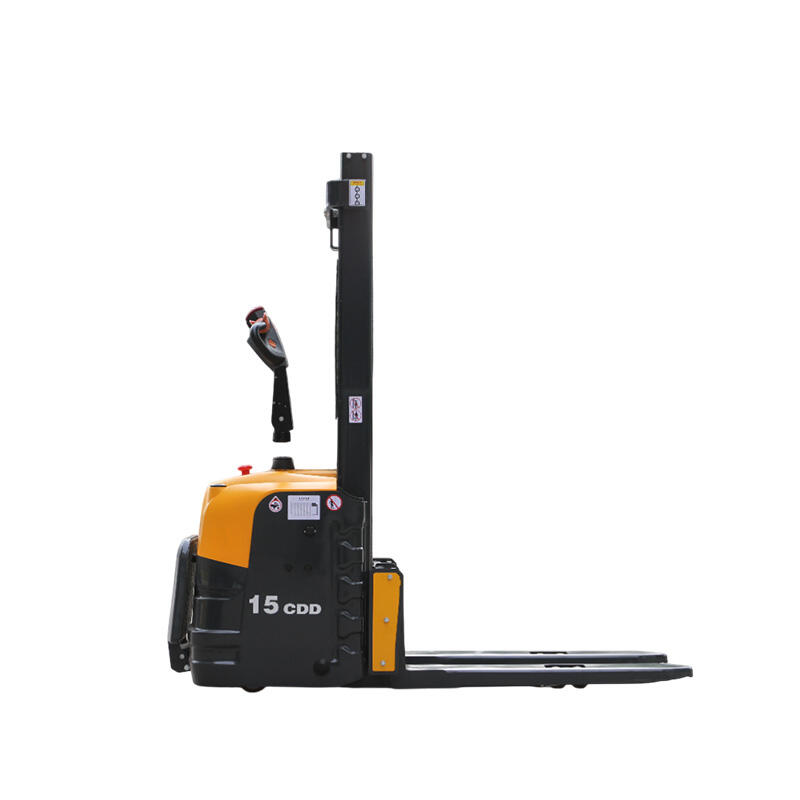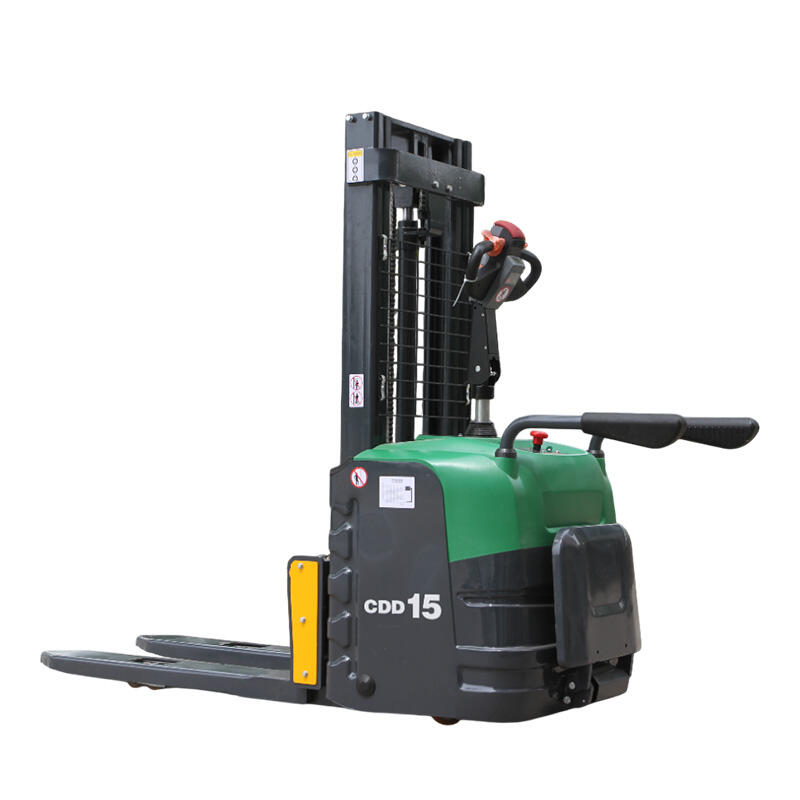A motorised pallet stacker is a dynamic material handling solution that combines motorised propulsion and lifting mechanisms to streamline the movement and stacking of palletized goods, offering a significant upgrade from manual or semi-manual alternatives. This equipment is engineered to reduce operator effort, enhance productivity, and improve safety in warehouses, distribution centers, manufacturing plants, and retail facilities, where the efficient handling of pallets is critical to operational success. By integrating electric motors for both moving and lifting, a motorised pallet stacker eliminates the physical strain associated with manual pumping and pushing, making it an ideal choice for high-volume operations and environments where operator comfort and efficiency are paramount. The design of a motorised pallet stacker is centered around two key motorised systems: one for propulsion and another for lifting. The propulsion system, powered by a rechargeable battery, allows the stacker to move forward and backward at adjustable speeds, typically ranging from 2 km/h to 6 km/h, depending on the model. This enables operators to transport pallets across long distances with minimal effort, reducing fatigue and increasing the number of loads handled per shift. The lifting system, also motorised, uses an electric motor to drive a hydraulic pump or a direct-drive mechanism, raising the forks to heights between 2 meters and 5 meters, with lifting capacities varying from 1,000 kg to 3,000 kg. This motorised lifting ensures smooth, precise movement, allowing for accurate placement of pallets on racks or shelves, even at maximum height. The battery that powers both systems is usually a lead-acid or lithium-ion battery, with lithium-ion options gaining popularity due to their faster charging times, longer lifespan, and consistent performance throughout the charge cycle. One of the primary advantages of a motorised pallet stacker is its versatility in handling various load types and pallet sizes. The forks are typically adjustable in width, accommodating standard pallets (1200x1000mm), Euro pallets, and custom-sized pallets, making it suitable for industries with diverse inventory, such as retail, food and beverage, and electronics. Some models feature a tilting function, allowing the forks to angle slightly to prevent goods from sliding off during transport—particularly useful for unstable or irregularly shaped loads. The stacker’s compact design, with a narrow chassis and tight turning radius, enables it to navigate through narrow aisles as narrow as 1.5 meters, making it suitable for warehouses with high-density storage configurations where space is limited. Safety is a core feature of a motorised pallet stacker, with multiple mechanisms integrated to protect operators, goods, and the surrounding environment. Overload protection systems monitor the load weight and prevent the stacker from lifting beyond its rated capacity, reducing the risk of tip-overs or structural damage. Emergency stop buttons are prominently located on the control handle and chassis, allowing for immediate shutdown in case of an emergency, such as a collision or equipment malfunction. The stacker’s low center of gravity and wide base enhance stability, even when lifting heavy loads to maximum heights. Many models also include automatic braking, which engages when the operator releases the control handle, preventing unintended movement. Additionally, the control handle is ergonomically designed with a comfortable grip and intuitive buttons, reducing hand and wrist strain during extended use, and improving operator control over the equipment. Operator comfort is a key consideration in the design of a motorised pallet stacker, with features that make long shifts more manageable. The control handle is often height-adjustable, allowing operators of different sizes to find a comfortable position. The smooth acceleration and deceleration of the propulsion system minimize jolting, reducing physical stress, while the motorised lifting eliminates the need for manual pumping, which can cause muscle fatigue. Some models include a fold-down platform for the operator to stand on during longer moves, eliminating the need to walk alongside the stacker and conserving energy. The quiet operation of the electric motors—typically below 70 decibels—creates a less stressful work environment, allowing operators to communicate easily and hear warnings from coworkers or other equipment. Motorised pallet stackers are designed to thrive in both indoor and controlled outdoor environments, though their performance may vary based on the model. Indoor-specific models often feature non-marking polyurethane tires that protect warehouse floors from scuffs and damage, while outdoor-capable models may have pneumatic tires to handle rough surfaces such as concrete, gravel, or asphalt. However, most motorised pallet stackers are primarily intended for indoor use, as their batteries and electrical components are not fully weatherproof, making them susceptible to damage from rain, snow, or excessive moisture. This focus on indoor use aligns with their common applications in warehouses, retail backrooms, and manufacturing facilities where protection from the elements is available. Maintenance of a motorised pallet stacker is relatively straightforward, with regular upkeep focused on ensuring the batteries, motors, and moving parts are in good working order. Battery maintenance involves regular charging—with lithium-ion batteries requiring no additional care beyond charging, while lead-acid batteries need periodic water refills to maintain electrolyte levels. The lifting mechanism, whether hydraulic or direct-drive, should be inspected for leaks (in hydraulic systems) or wear (in direct-drive systems), with lubrication of moving parts such as hinges and rollers to ensure smooth operation. The propulsion system’s wheels and bearings should be checked for wear, and the control system’s wiring and buttons should be inspected for damage to prevent electrical faults. Cleaning the stacker regularly to remove dirt, debris, and pallet fragments helps prevent rust and ensures that all components function correctly, extending the equipment’s lifespan. Cost-effectiveness is a significant benefit of investing in a motorised pallet stacker. While the initial purchase price is higher than that of manual or semi-electric stackers, the increased productivity and reduced labor costs quickly offset this investment. By allowing operators to handle more loads in less time, the stacker increases throughput, enabling businesses to process more orders or move more inventory without adding additional staff. The reduction in operator fatigue also lowers the risk of workplace injuries, which can result in costly medical bills, workers’ compensation claims, and downtime. Additionally, the long lifespan of motorised components—with proper maintenance—ensures that the stacker remains operational for years, providing a strong return on investment. The applications of a motorised pallet stacker are diverse, spanning multiple industries and operational contexts. In e-commerce fulfillment centers, it is used to retrieve pallets from storage racks and transport them to picking stations, where items are sorted for individual orders. In retail, it moves inventory from backroom storage to sales floors, with its compact size allowing it to navigate around displays and customers. In manufacturing, it transports raw materials to production lines and finished products to shipping areas, integrating seamlessly into assembly workflows. In food and beverage warehouses, it handles pallets of canned goods, bottles, or frozen items, with some models designed to operate in cold storage environments (down to -20°C) with cold-resistant batteries and components. In conclusion, a motorised pallet stacker is a powerful, efficient, and user-friendly material handling solution that transforms how businesses manage palletized goods. Its motorised propulsion and lifting systems reduce operator effort, enhance productivity, and improve safety, making it an indispensable tool in modern logistics and warehousing. By combining versatility, maneuverability, and reliability, it meets the diverse needs of industries ranging from retail to manufacturing, ensuring that pallets are moved and stacked with precision and ease. For businesses looking to optimize their material handling processes, reduce labor costs, and create a safer work environment, a motorised pallet stacker is a strategic investment that delivers long-term value.


